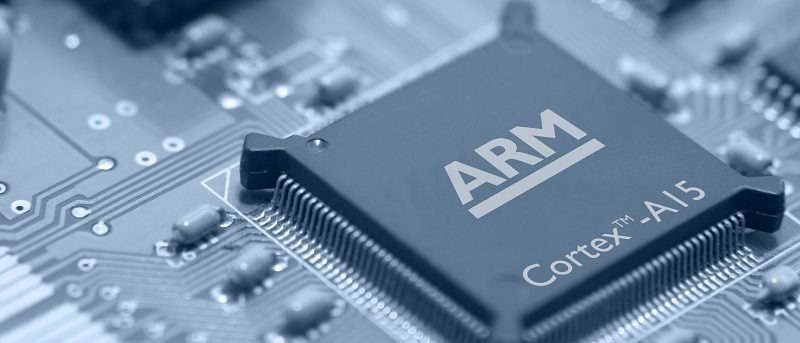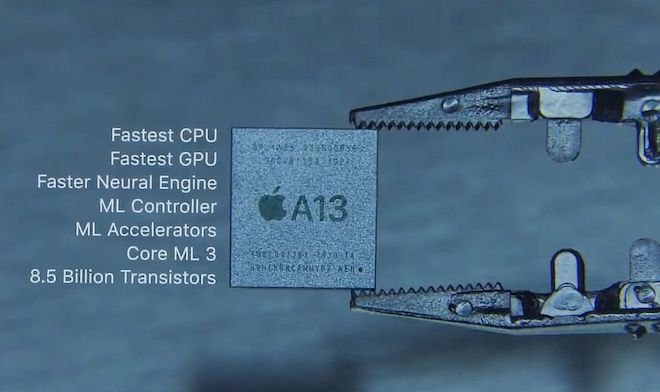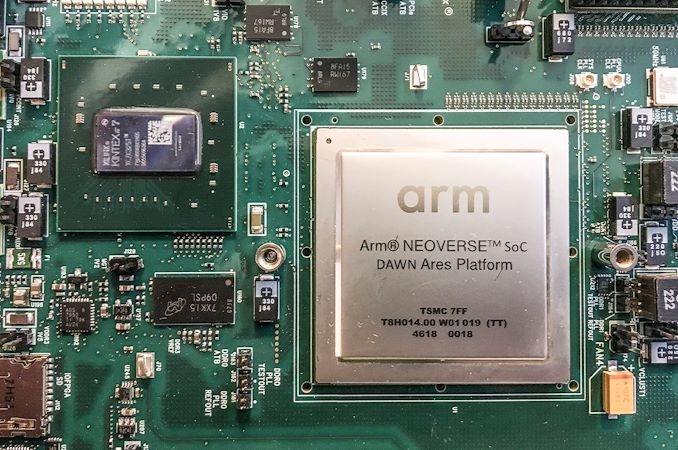The groundwork is set for Apple 'Pro' ARM Mac chips
ARM chips have largely been left out of the personal computer and datacenter markets. But the tides may be shifting in 2020.

ARM chips power most of the world's smartphones and tablets, but there are high-performing ARM chips in data centers now. Apple may not need to wait long — if at all — for speed in a high-end ARM Mac.
For most desktop, laptop or datacenter applications, Intel's x86 chips have long been the industry standard. But amid rumors of Apple's switch to first-party silicon for an ARM Mac, there are a handful of manufacturers pushing high-performance ARM chips to the market.
Here's why that's significant, and how Apple's abandonment of Intel could kickstart a broader switch.
Differences between ARM and x86 chips
ARM chips are much more power-efficient than Intel x86 chips, and generally offer better performance-per-watt. That's due to a variety of reasons, including a simpler instruction set, the use of fewer transistors and overall slower clock speeds.
The power efficiency of ARM, along with other factors like a low cost of production and development, has largely led ARM chips to become the industry standard for most mobile devices like smartphones, tablets, and lightweight PCs like select Google Chromebooks.
But when it comes actual high-performance chipsets, particularly for use in desktops computers or laptops, the assumption has long been that Intel's x86 is the natural choice. That's been the case for a long time, and Intel's steadily increasing dominance could be even be seen in Apple's switch from PowerPC to x86 in 2005.
The same is true for data centers and servers. While minor exceptions do exist, the vast majority of the web's architecture is still based on Intel's chip design instructions. Intel is still the leader in terms of market share (nearly to a monopolistic degree), with AMD x86-based chips making up the lion's share of the scraps.
There have been talks of a broader shift to ARM-based servers since the early 2010s. Nearly a decade later, ARM chips are used in some server applications, but their overall market share pales in comparison to its x86 competitors.
But as the lines blur between mobile device and laptop, and datacenter operators are increasingly looking at more efficient and cheaper server options, 2020 is the year when things could start to change.
The current state of ARM processors
One interesting thing about the current ARM chip industry is that the majority of ARM processors in use are based on custom chip designs.
Apple's A-series system-on-chips (SoCs) are a prime example, especially because they show off the potential power of ARM processors. Apple currently makes the fastest smartphone chips on the market, which allows its iPhones to keep up with or beat rival Android devices that appear to have better specifications on paper. To get this done, Apple designs its chips in-house and only relies on the larger ARM ecosystem for processor instructions.
The latest A13 Bionic iPhone chip, for example, approached the performance of some desktop CPUs. And beyond Apple, companies like Qualcomm, MediaTek and other manufacturers also take the ARM chip design instructions and apply them to their own custom silicon.
While ARM chips aren't widely used in servers or datacenters, many third-party manufacturers have been designing their own ARM-based chips aimed specifically at that market. These server processors aren't a straight drop-in to existing desktop hardware, but given Apple's use of Intel Xeon processors, it isn't that far off.
In March 2020, Ampere debuted an ARM-based 80-core server processor called the Altra, which the firm projects will offer 2.11 times better power efficiency and up to 2.23 times better in raw performance than an Intel Xeon Platinum 8280.
For comparison's sake, the Xeon Platinum 8280 is a Cascade Lake chip released in the second quarter of 2019 that sports 28 cores, 2.7GHz base frequency and a 205W thermal rating. Used in a rack setting, Ampere even goes so far as to say a rack of Altra processors can offer up to 120% better raw performance than the 8280, ARS Technica reported
Back in 2018, Amazon announced its first ARM-based server chip, the Graviton. Though that server chip didn't appear to make a lasting impact on the market, Amazon announced a new chip in March 2020 called the Graviton 2, which the company says offer better price-performance than AMD and Intel in many server workloads.
Amazon says users of its Elastic Compute Cloud, or EC2, web service can expect 40% better price-performance. For cloud-based companies or software-as-a-service firms, that could offer serious competitive advantages, since they would be spending less money on comparable service speeds.
Marvell, the volume leader in ARM server chips, also unveiled a new ThunderX3 "Triton" chipset, a piece of 240W silicon with 96 cores. According to Marvell, the ThunderX3 consistently offered better performance than Intel's 2019 Cascade Lake-SP chips across several cloud-based workflows, such as MySQL or CDN.
While third-party ARM chips are out there, ARM Holdings, the company that designs the ARM chip instructions, is also getting into the market itself. Perhaps most interesting is the company's laptop chips, which have long lagged behind Intel but appear to be catching up.
The Cortex-A76, first implemented in hardware in 2019, is a laptop chip that offers roughly the same performance as an Intel Core i5-7300, ARM chief architect Mike Filippo told CNET. That isn't quite stunning performance, but it suggests that ARM is looking to catch up to Intel and beat them at their own market.
ARM Holdings's first-party server architecture has been making a splash in the arena, too. In 2018, the company announced a revamp of its server architecture dubbed Neoverse N1. (Which, it's worth noting, is the architecture that most of the aforementioned chips, like the Altra and Graviton 2, is based on.)
Since then, ARM Holdings has released some very ambitious server chips, such as 2019's Ares design.
The significance of high-performance ARM chips
It's no secret that Intel's pace of performance upgrades has been slowing down, and the company is suffering from other problems, too. The issue is that the company essentially argues that the performance ceiling has largely been hit and it's already taking full advantage of what's possible with modern-day computers.
But ARM is offering a different take with its chips, promising in 2018 that each generation of its future chips would be at least 30% faster than past generations. That's far beyond what Intel is promising with its current chip design.
That's just the first-party silicon designed by ARM itself. That doesn't address the third-party custom chips made by Apple and other companies, which have largely proven to be massive market successes in tablets, smartphones and IoT devices.
To put all of this plainly, it's looking like ARM and other chipmakers are investing serious resources into creating chips that can compete with x86 processor. Not just at the low-end consumer use case, but also at both the desktop and server level, leaning more towards high-performance computing.
As far as the impact to users, there are some big ones. As mentioned before, ARM chips are generally more power-efficient. With their speeds catching up, it could lead to devices with much longer battery lives that still pack a performance punch. They also produce less heat than Intel chips, and when combined with computer or server cooling mechanisms, could suffer less from performance throttling.
The cost of manufacturing and ease of deployment may also play major roles, perhaps bringing down the cost of computers or other electronics over the long-term at the consumer level.
And high-performance ARM chips are coming at a time when Intel is floundering. The company has made various broken promises on performance upgrades and missed deadlines, not to mention the fact that chip-level Intel vulnerabilities have made a lot of devices less secure.
ARM hasn't had those problems, historically. While that's largely attributable to market share, it could mean that many computer manufacturers will be given a fresh start.
The future of ARM chips
ARM has largely taken a backseat to Intel's x86 when it comes to the devices, like servers and workstations, that power our world's work. But there are some undercurrents in the industry that could suggest the tides are shifting.
Apple's expected ARM MacBooks will likely be a tipping point, depending on what kind of performance Apple's custom Mac chips will offer. But Project Catalyst could also be a major factor for a broader shift to ARM, since it's encouraging popular app developers to seriously consider supporting the ARM architecture.
Microsoft, Apple's chief competitor in the laptop space, also debuted a new line of Surface devices in 2019 that sport what the company calls the first 3GHz ARM-based chip — the SQ1.
The ongoing COVID-19 outbreak could also spur a shift to ARM in the server and datacenter spheres since major companies are going to seriously consider their performance-per-dollar metrics on critical hardware going forward. ARM server chips are cheaper than Intel ones, and as we've covered, their performance-per-watt tends to be better.
There are other factors, too. The needs of data centers everywhere are rapidly evolving. Because Intel is on the verge of becoming a monopoly in the server space, switching to ARM servers is a good way for data center operators to source processors from a wider range of suppliers.
Of course, it will undoubtedly take some time for ARM to become as firmly entrenched in our day-to-day Macs as Intel. But there are now signs on the horizon that it's becoming a serious possibility, rather than a far-fetched prediction.
Apple and an ARM Mac
Apple probably isn't going to take an A-series processor and drop it straight into a Mac. A custom chip, tailored for Mac use like other ARM chips are tailored for the server market, is the most likely scenario. It doesn't have to wait for high-end chips, but it probably will in the interest of a smooth transition for that market.
The conventional wisdom is that Apple will start at the low-end, like the MacBook and Mac mini. Specifically, with laptops, ARM-based chips are particularly well-suited to deliver excellent battery life with no compromises to performance. After some period of time that isn't clear yet, it will move the chips up to the "Pro" level hardware — probably when the "Pro" user base demands it.
Right now, today, Apple could deliver high-end performance with workstation chips similar to the Altra and ThunderX3 in the same thermal and power envelopes that the iMac Pro and Mac Pro use now with the Xeon processor. The software would have to follow — which is why that transition probably won't be day and date with the lower-end models.
Looking at the broader picture, Apple would obviously benefit from having tighter control over its entire stack, a goal that it has already attained on the iPhone and iPad. And consumers will probably enjoy Mac performance gains akin to the iPhone's outpacing of most rival devices — not to mention significant battery life improvements and a potential reduction in cost for Apple.
The transition may not be the smoothest, particularly for developers or users reliant on non-updated plugins and software. But taking developments like Project Catalyst into account, it does seem inevitable.
 Mike Peterson
Mike Peterson












 Wesley Hilliard
Wesley Hilliard
 Andrew Orr
Andrew Orr



 Amber Neely
Amber Neely

 William Gallagher
William Gallagher







